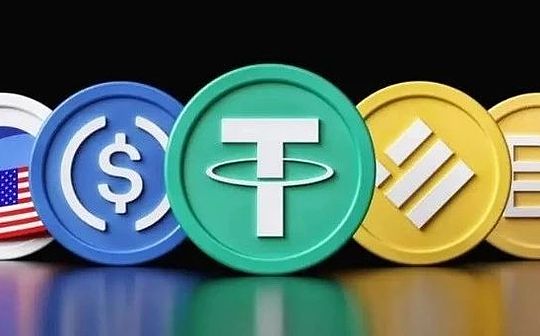
Source: Aiying Payment Compliance
From the Token Terminal data, we can see that the monthly stablecoin transfer volume has increased tenfold over the past four years, from US$100 billion per month to US$1 trillion on June 20, 2024, the total of the entire cryptocurrency marketTrading volume was $74.391 billion, while stablecoins accounted for 60.13% of that, about $44.71 billion.Among them, USDT (Tether) is the most used, with a market value of US$112.24 billion, accounting for 69.5% of the total value of all stablecoins.On June 20, USDT’s trading volume reached US$34.84 billion, accounting for 46.85% of the total trading volume that day.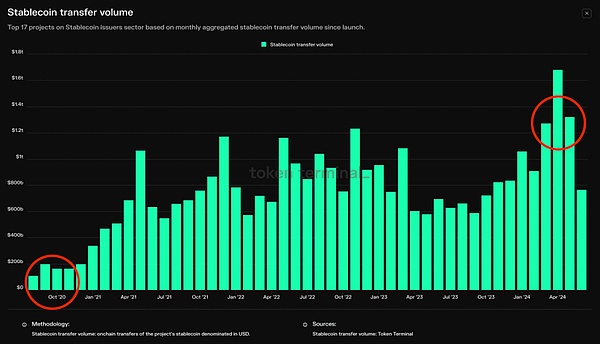
Stablecoins, as an important existence in the cryptocurrency market, are basically defined as cryptocurrencies that are pegged to fiat currencies or other assets to achieve stable value.The Bank of International Settlements defines stablecoins as “cryptocurrencies whose value is pegged to fiat currencies or other assets.”This design is designed to enable stablecoins to maintain stable value relative to pegged specific assets or packages, thus achieving a stable store of value and medium of exchange.This mechanism is very similar to the gold standard, but because it is issued on the blockchain, it also has the characteristics of decentralization of crypto assets, peer-to-peer transactions, no central bank clearing and untamperable.
This report of Aiying will explore the definition of stablecoins and their main models, analyze the current market overall picture and competitive trend, and focus on introducing the operating principles, advantages and disadvantages of fiat currency collateral, crypto asset collateral and algorithmic stablecoins, as well as different types of stablecoins.Performance in the market and future development prospects.
1. Definition and main mode of stablecoins
1. Basic definition: anchor fiat currency, stable value
Stablecoins are literally cryptocurrencies with stable value. Bank of International Settlements defines stablecoins as: cryptocurrencies whose value is pegged to fiat currency or other assets.In extension, the main purpose of establishing a stable currency is to maintain stable value relative to the pegged specific assets or package assets to achieve a stable store of value and medium of exchange, which is actually very similar to the gold standard.Since it is issued on the blockchain, it also has the decentralized, peer-to-peer nature of crypto assets, no need to be cleared by the central bank, and is tamper-free.
The main difference between the stability of the value of stablecoins and the traditional central banks’ pursuit of the stability of the currency value of fiat currency is that stablecoins pursue exchange rate parity relative to fiat currency, while the value of fiat currency pursues the stability of cross-term purchasing power.More simply, stablecoins essentially hope to anchor the fiat currency system to achieve stability in the value of tokens.
2. Main model: The main difference between mortgage assets and centralization
For stablecoins, if they want to ensure the anchoring of the fiat currency system, they are divided into two categories according to the endorsement of the underlying assets, including mortgage and unsecured, and are divided into centralized and decentralized in terms of issuance.For value stability, using real-world valuable assets as collateral and then issuing stablecoins to achieve anchoring with fiat currency is the easiest and relatively safe way to achieve implementation, and a higher mortgage rate means sufficient solvency.According to the classification of collateral, it will be further refined into fiat currency mortgage, crypto asset mortgage, and other supporting asset mortgages.
There can be specific subdivision methods as follows:
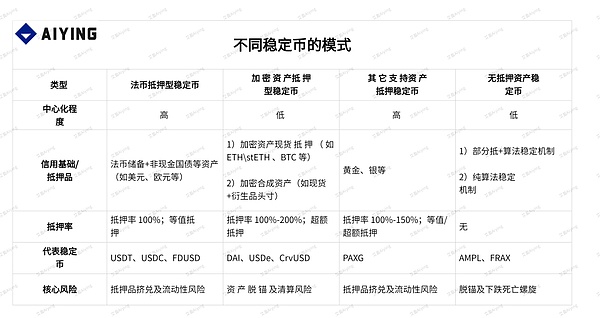
From the above table, we can see that from the basic operating model, the stability of the value of stablecoins mainly relies on collateral assets or algorithmic regulation to stabilize the price of stablecoins within a controllable fiat currency exchange range.The key is not how to fluctuate the currency price, but how to reasonably correct this fluctuation so that it can operate in a stable range.
2. The overall picture and competitive situation of the stablecoin market
1. From the perspective of anchored fiat currency: the US dollar accounts for almost the entire market
From the perspective of anchoring prices, in addition to anchoring gold prices such as PAXG, 99% of stablecoins are anchored to the US dollar 1:1, and there are also stablecoins that anchor other fiat currencies, such as EURT anchoring the euro, with a market value of US$38 million, the market value of yen such as GYEN is currently only US$14 million; IDRT, which is anchored to the Indonesian rupiah, has a market value of US$11 million.The overall market value is very small.
The proportion of stablecoins anchored to the US dollar currently remains at around 99.3%, and the remaining are mainly composed of the euro, Australian dollar, British pound, Canadian dollar, Hong Kong dollar, RMB, etc.

Stablecoin anchors fiat currency market share Source: The Block
2. From market share and market value: USDT is the absolute overlord, USDC is chasing
The issuance of stablecoins is closely related to the market. From the monitoring data, it can be seen that the overall issuance volume continues to grow, but it fell during the last round of bull-to-bear period (March 2022). It is currently in the upward stage of marginal issuance.Synchronization also indicates the current bull market.

Chart 3: Historical issuance of stablecoins (Source: The Block)
According to the latest data from coingecko, as of May 4, USDT’s current market share in the stablecoin track was 70.5%, followed by USDC 21.3%, DAI 3.39%, FDUSD 2.5%, and FRAX 0.41%.
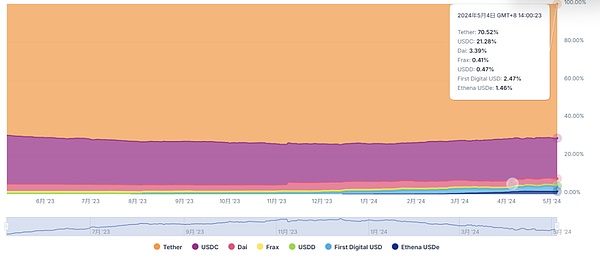
Chart 4: Stablecoin track market share Source: coingecko
In addition, from the perspective of market value, the current market value of all stablecoins is US$160 billion+, of which USDT is far ahead and has a stable growth. Its current market value exceeds US$110 billion. USDC’s market value has risen steadily to US$33 billion+, but there is still a gap compared to USDT, other stablecoins remain basically stable.
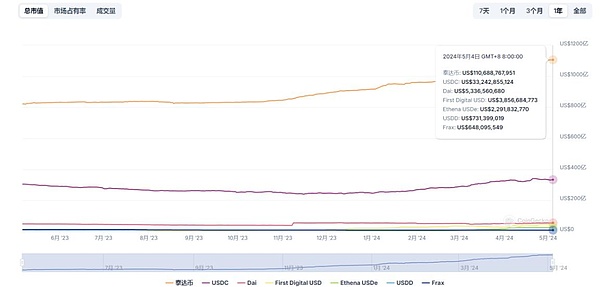
Chart 5: Market Capacity of Mainstream Stable Coins Source: Coingecko
3. From the top ten market value, fiat currency mortgage stablecoins occupy the absolute leader, covering all types of stablecoins
Judging from the top ten mainstream stablecoins at present, the centralized US dollar-collateralized stablecoins are mainly composed of USDT\USDC\FDUSD and other broad collateralization rates are basically greater than 100%; DAI is a decentralized crypto assets collateralized stablecoins; USDe is a synthetic US dollar,The collateral is a crypto asset; FRAX is an algorithmic stablecoin, and PAXG is a stablecoin collateralized by gold.
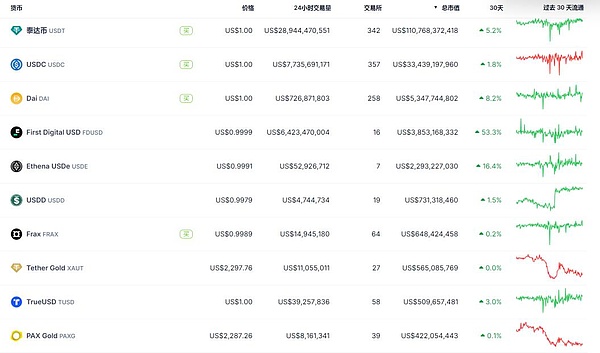
Chart 6: Market Capacity of Mainstream Stable Coins Source: Coingecko
4. From the perspective of coin holding address: USDT is generally stable, USDC has been weak recently
From the changes in the two coin holding addresses, it can be clearly seen that the plunge in the two coin holding addresses was due to the dean of the US dollar. On March 11, 2023, USDC was affected by the SVB storm, and once deaned from the US dollar and fell to the US dollar.About 0.88, causing the coin holding address to drop rapidly. Although the lost ground was subsequently recovered, the coin holding address was once again pulled open by USDT.
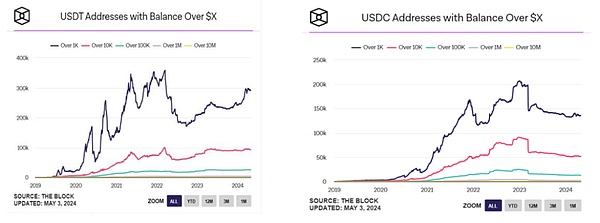
Chart 7: USDT vs USDC Coin Holding Address Change Source: The Block
As can be seen from the figure above, after the dean event, USDC’s address has been reduced across the board from more than US$1,000 to more than US$10 million.It fell by about 30% from the peak, and the corresponding steadily increased USDT.
3. The operating principle of mainstream stablecoins, what are the advantages and disadvantages?
Continuing the above analysis, the current mainstream stablecoins are mainly distinguished according to the type of collateral assets and the degree of centralization of issuance. Generally speaking, most of the issuances with fiat currency are mainly issued, and currently occupy the mainstream of the market; they are mortgaged by crypto assets or algorithmicMost stablecoins are issued in a decentralized manner, and each track has its own leader.The design framework of each stablecoin has its advantages and disadvantages.
1. Fiat currency mortgage stablecoin (USDT\USDC)
1) The main operating principle of USDT
-
Basic introduction:
In 2014, iFinex’s company Tether created the stablecoin USDT, and the company also owns the cryptocurrency exchange Bitfinex, which is registered in the British Virgin Islands, headquartered in Hong Kong, and Tether is headquartered in Singapore.The current CEO is Paolo Ardoino (formerly CTO of the company), an Italian. In the early days, he mainly developed trading systems for hedge funds. He joined Bitfinex as an executive in 2014 and joined Tether in 2017. He currently owns 20% of Tether’s shares.
-
Issuance and circulation:
The first step is to deposit US dollars into Tether’s bank account; the second step is to create a corresponding Tether account for the user and mint a corresponding value of USDT in his account; the third step is to register the account.The fourth step is the redemption stage. If the user redeems the US dollar, the USDT must be handed over to Tether Company. The fifth step is to Tether destroy the corresponding value of USDT and return the USD to the user’s bank account.
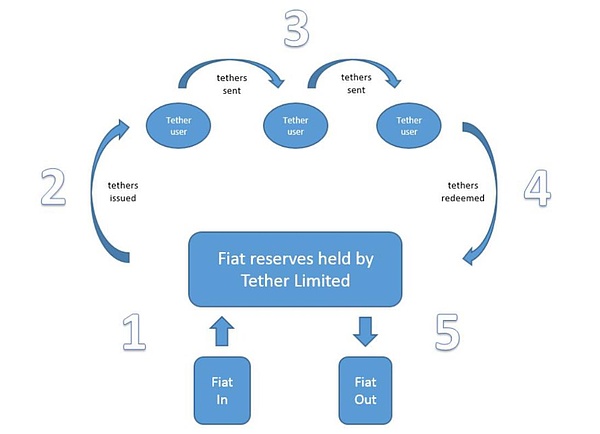
Chart 8: USDT Issuance, Transaction, Circulation, Recycling Full Process Source: Tether Company White Paper
Technical implementation:
Tether issuing USDT to achieve the above process requires the embedding of blockchain technology. The overall technical architecture is not complicated and is mainly divided into three layers.
-
The first layer is the main blockchain network, the early days were mainly Bitcoin blockchain, and it has now expanded to 200+ public chains. USDT’s transaction books are embedded in the blockchain through the Omni layer protocol.
-
The second layer is the Omni layer protocol(Omni Layer Protocol), a protocol that mainly serves the Bitcoin blockchain for minting, trading and storing USDT.After 2019, USDT casting has gradually shifted to Tron and Ethereum, mainly using the TRC-20 and ERC-20 protocols.
-
The third floor is Tether Company, mainly responsible for issuance and management and audit of mortgage assets, etc.
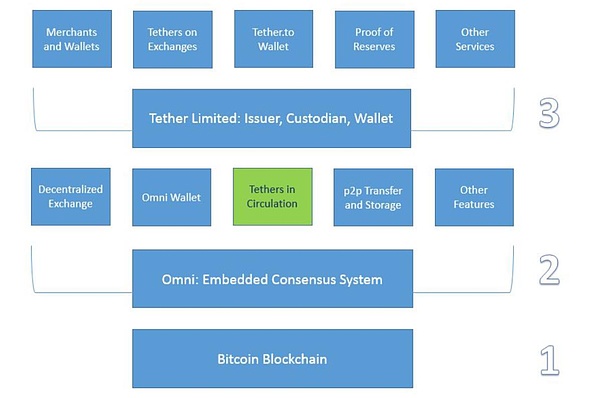
Figure 9: USDT technology implementation architecture (taking Bitcoin network as an example) Source: Tether Company White Paper
In the above issuance and technical implementation, the most fundamental thing is the Proof of Reserves operating by Tether. Specifically, as long as a USDT is cast, the corresponding Tether company must increase its reserve by 1 USDT. In other words, it will issue USDT.The corresponding mortgage should be increased equally by USD 1 to ensure 100% equal mortgage.
Asset (collateral) reserve status:
The current total asset reserve is $110 billion+, which is consistent with its current market capitalization.From the perspective of asset reserve categories, cash and cash equivalents account for 83%, while others account for 17%.
In terms of segmentation, among cash and cash equivalents, short-term US Treasury bonds account for about 80%, followed by overnight reverse repurchase agreements close to 12%, while the remaining ones are money market funds, cash and bank deposits, fixed repurchase agreements, non-U.S. Treasury bonds.Among other asset classes, it is mainly composed of Bitcoin, high-grade corporate bonds, precious metals, and mortgage loans, among which Bitcoin and mortgage loans account for a large proportion.

Chart 10: Tether’s asset reserve composition (data as of the first quarter of 2024) Source: Tether’s official website
In addition, it can be seen from the audit reports over the past three years that Tether has kept up with the external macro environment in terms of asset reserves, and the proportion of US short-term Treasury bonds, money market funds, etc. has continued to expand, and at the same time reduced corporate bonds, cash and bank deposits..In addition, due to the different maturity of its assets, this is the most likely situation to short USDT. According to the data disclosed in the audit report, the current Treasury bonds and regular repurchase agreements it holds are both ultra-short-term, less than 90 days, the only longerThe company is corporate bonds and non-U.S. Treasury bonds with maturities of less than 150 days and less than 250 days.
The allocation of these reserve assets indirectly increases the income of their asset operations, and also further reduces their risk coefficient. The security of assets is further improved, especially the shortening of maturity, which advantageously prevents short selling caused by maturity mismatch.
Profit model:
-
Cost side: A very small number of technical and operation and maintenance personnel, with extremely low marginal costs
-
Income side: Service fees after registering KYC (USD 150 per person), inlet and withdrawal fees (about 0.1%), interest income (such as 4-5% income for short-term Treasury bonds, but its cost is 0, and other loan interest income is also available), custody fees (the fees entrusted by some institutions in Tether. In the first quarter of 2024, Tether announced its net profit in the first quarter of US$4.5 billion, a record high, but its number of employees was only about 100, which is the same profit as Goldman Sachs,Morgan, the number of people is more than 50,000. It is very rare to make money.
2) The main operating principles of USDC
Similar to USDT, the main issuance, circulation and technical implementation of USDC are similar, pegged to 1 USDC for USD1. The stablecoin created by Coinbase and Circle in 2018 was later than USDT, but in terms of specific operation details,There are certain differences overall:
-
More transparency in asset reserves: Compared to USDT’s quarterly disclosure of asset reserves, USDC discloses its assets monthly.The asset reserves are audited every year by a third-party auditing agency, mainly Grant Thornton in the early stage, and changed to Deloitte in 2023.As of March 2024, USDC in circulation was US$32.2 billion, and circle equivalent assets were approximately US$32.2 billion.Basically the same.

Chart 11: The entire process of USDT issuance, trading, circulation and recycling
Most asset reserves are short-term Treasury bonds and cash, with shorter maturity and higher liquidity than USDT: Compared with USDT, which only discloses the overall maturity of Treasury bonds, USDC will announce the maturity date of its major Treasury bond assets. According to data disclosed in March, the maturity is allWithin 3 months, the latest is short-term bonds due in June, with an overall scale of US$11.4 billion; in addition, they are mainly repurchase agreements and cash reserves, which together have US$28.2 billion, and in addition, there are US$4.2 billion in cash.Overall, it is placed in the CRF (Circle reserve Fund) registered by BlackRock in the SEC. Overall, about 95% of its assets are under the supervision of the SEC. In addition, due to the higher cash ratio of its assets, the liquidity at the redemption level isAlso higher than USDT.
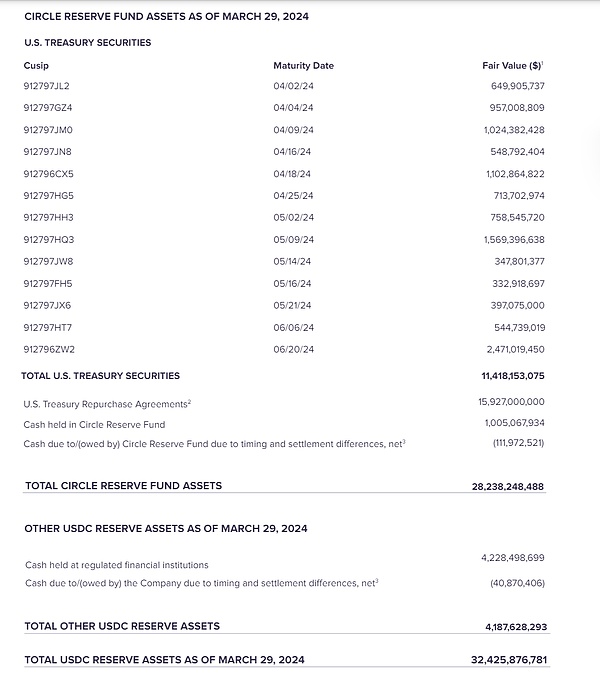
Chart 12: USDC Reserve Assets (as of March 2024) Source: Circle Official Website
-
The USDC was founded under the regulatory framework of the United States, with a higher legal status: Circle registration is a monetary service business organization under the U.S. Treasury Department’s financial crime execution network, and it is also carried out in accordance with the state’s laws on currency transmission business, and is regarded as a regulatory as a whole.A prepayment method.Compared to USDT, USDC’s reserve assets are independent, assuming that Circle goes bankrupt, these reserve assets will be protected under the New York Banking Act and the Federal Banking Act.
-
USDC does not redeem directly with individuals.USDT For more than $100,000, you can directly redeem Tether as long as you pay the registration fee, but Circle runs at the customer level.Only its partners or Class A users (exchanges, financial institutions) are eligible to redeem with Circle.Individual ordinary users (Class B) need to be expanded through third-party channels (such as coinbase).In addition, in terms of profit sources, USDC and USDT are basically the same, but since USDC assets are mainly short-term Treasury bonds and cash, the risk exposure is lower than USDT, so the yield is also relatively low.
3) Main operating principles of FDUSD
After the New York State Department of Financial Services ordered cryptocurrency company Paxos to stop issuing new BUSDs, Binance, the world’s largest exchange, also stopped supporting BUSD products on December 15, 2023, and announced and automatically exchanged the BUSD balance to FDUSD.Since then, FDUSD’s market value has been rising, occupying the third place in the stablecoin market with fiat currency collateral.
-
Basic introduction:
FDUSD is a US dollar-based stablecoin launched by FD121 (First Digital Labs) in June 23. The parent company First Digital Trust is a qualified custody and trust company in Hong Kong, mainly engaged in digital assets related businesses. It was employed in 2017 byLegacy Trust was established and officially became a completely independent public trust company in 2019, while Legacy Trust is a veteran public trust company established in 1992.
-
Running mode:
FDUSD is basically not very different from USDT\USDC’s operating model. When the user deposits US dollars, the issuer mints the corresponding number of FDUSDs.Similarly, if US dollars are withdrawn, the corresponding number of FDUSD will be destroyed.FDUSD’s auditing agency is Prescient Assurance (an accounting firm based in New York, a CREST-certified top 20 security testing and auditing organization in the world), and contract audit is Pai Shield.
-
Asset disclosure and reserve status:
Similar to USDC, FDUSD also discloses its assets monthly. Its reserve assets are mainly managed by a public trust company in Hong Kong. It does not disclose the specific name of the financial institution where the reserve assets are located, but it is clear that these financial institutions are all Standard & Poor’s.A-2 credit rating under rating.As of March 2024, the FDUSD issued and circulated was US$2.5 billion, and the corresponding reserve assets were also US$2.5 billion.In terms of reserve assets classification, short-term Treasury bonds are US$1.86 billion, the latest maturity date is May 21, fixed deposits are US$265 million, the term last night was 1 month fixed, and other cash assets are US$170 million.Overall, they are ultra-short-term assets, with very high liquidity and instant compensation effects.
4) Summary of the track of stablecoin mortgage
If you review the top three fiat-collateralized stablecoins of USDT, USDC and FDUSD, you can see in detail
Three different paths to success.A brief summary is as follows:
-
USDT: 1) The biggest advantage is the first-mover advantage, but the rise is mainly due to the support of the exchange and the market explosion.In the wilderness of cryptocurrencies, from the early Bitcoin blockchain to the later Ethereum ecosystem, USDT is a well-deserved pioneer, and at the same time guessed that the market exploded. If you look back at its coin address and market value, although in 2014It was established in 2017, but its real rise was in 2017. In addition to the bull market, USDT began a super issuance, which was criticized by the market for manipulating the price of Bitcoin. However, in hindsight, this is a causal inversion, and the one that is easily overlooked was the one that wasIt was China that closed the virtual currency, and more importantly, USDT simultaneously launched the top three exchanges that year.2) Being attacked by risky events, but respond in a timely and appropriate manner to quickly restore market confidence.Tether’s affiliate Bitfinex Exchange was once considered a company by the outside world. From 2014 to 2016, it was successively hacked and fined by the US government, including Tether’s international wire transfers cut off by Wells Fargo and Taiwan Bank, and even decoupled from the US dollar for a while.The main method of dealing with it is to quickly announce its asset reserves, including its excess reserves and undistributed profits, and to restore market confidence through the health of its financial situation. Whether or not its data is fake, it is indeed a very powerful response.Market concerns.Through first-mover advantage and several market PR, USDT has formed a strong consumption habit for consumers and is still the most preferred stablecoin for deposits and withdrawals, including trading pairs that cover the most complete exchanges.
-
USDC: 1) Rising in the USDT crisis, transparent, regulated, and more liquid asset reserves won the favor of customers.If we look back at the rise of USDC, the increase in its coin-holding address usually corresponds to the decline in USDT’s coin-holding, which is usually the time when USDT has risk events, especially since it was the only stablecoin trading pair of coinbase in the early stage.This kind of regulatory support has brought great benefits to the expansion of the early USDC market and is also its main competitiveness to impact USDT’s first throne.2) Due to compliance, the Defi protocol prefers USDC, and liquidity mining has enabled USDC to quickly increase volume and has a better advantage on the chain.After Maker introduced the regulated stablecoin USDC in 2020, USDC has become the first choice for major Defi protocols. Currently, the three major Defi protocols, MakerDAO, Compound and Aave, are the main supporters of USDC. Beyond the benefits of regulation, this is behind this.More importantly, as collateral for the Defi agreement, USDC has lower volatility compared to USDT.USDC’s victory can be summed up as compliance victory.But it is worth noting that in August 2023, Circle freezes Tornado Cash (money laundering charges) USDC as directed by the US Treasury Department, which also makes it difficult for the decentralized Defi protocol to rely too much on the center.Stablecoins have laid the factors of divergence.
-
FDUSD: 1) The support of top exchanges and implicit regulatory compliance have become one of the main reasons for FDUSD’s rise.The top 1 cryptocurrency exchange Binance decided to abandon BUSD in 2023 and switch to support FDUSD in July of that year as its only designated stablecoin for liquidity mining of Launchpad and Launchpool, thanks to the huge amount of Binance mining and new issuance.Revenue, FDUSD’s overall market value has grown rapidly, rapidly growing into the top three fiat-collateralized stablecoins in the market.The rise of FDUSD, Binance’s support can be said to be the most direct factor. What is more important is that the market does not lack legally regulated stablecoins (USDCs). Binance’s choices have more considerations on the regulatory environment of Hong Kong and the United States’ U.S. for Binance.As the FDUSD born in Hong Kong, it has become the best choice.2) Scenario-based and wealth effects determine their growth rate and upper limit.Assuming FDUSD is adopted by the exchange, it will be difficult to achieve its rise without suitable application scenarios.After Binance was launched, FDUSD became the only second mining cryptocurrency for Launchpool and Launchpad (the other is BNB). Since its launch, the average mining income through FDUSD mining has reached nearly 70%, which is for short-term mining users.It is to determine the higher returns, and this alone quickly increases the usage rate of FDUSD.
Overall, for stablecoins that are only mortgaged by fiat currency, their success is inseparable from several important factors:
-
Whether it is developed under the regulatory framework will help gain user trust in the early stage.For example, USDC, FDUSD, etc. are all the same.
-
It is the audit, security and transparency advantage of reserve certificates.(For example, TUSD launched a real-time audit function in 2023, including using chainlink to ensure the security of coin minting, etc., to make this old stablecoin shine again; for example, the rise of USDC is also due to this factor).
-
It is the support of the exchange and extensive cooperation that determines the lower limit of development.The rise of USDT to USDC and FDUSD is inseparable from the support of exchanges. Only with the huge liquidity support of these exchanges can stablecoins achieve a stable start.
-
Application scenarios and wealth effects determine the speed and upper limit of development.The more typical examples are FDUSD, USDC, and PayPal launched PYUSD (parasitic in Paypal wallet) as mentioned above. The key to its rapid development is that it has formed a strong wealth effect or more convenient services in a certain segmented scenario.This improves user adoption rate.
2. Crypto Assets Pledge Stable Coins (DAI/USDe)
Due to the huge volatility of crypto assets, their credit basis is weaker than risk-free assets in USD (treasury bonds, USD deposits), etc., so they are generally over-collateralized, but the synthetic USD through derivative hedging mode can also achieve close to 100 yuan% mortgage rate; but because of the crypto assets used, they usually have the characteristics of decentralization.
1) The main operating principles of DAI
-
Basic introduction:
DAI is currently the leader in decentralized stablecoins Maker DAO, which was officially issued and managed in 2017.MakerDAO is a decentralized finance (DeFi) project headquartered in San Francisco, USA and founded by RuneChristensen.Project investors include well-known investment institutions in the crypto industry such as A16z, Paradigm, and Polychain Capital. They were mainly operated by the Maker Foundation in the early days and are currently managed by its community through a decentralized autonomous organization (DAO) (holding MRK tokens).
-
Main operating mechanism:
DAI also anchors the dollar 1:1 overall.The Maker Agreement launched in 2017 but collateralized DAI mainly allows users to mint DAI by pledging ETH; in 2019, it launched a multi-collateralized DAI to accept collateral other than ETH. In addition to the changes in collateral, it also introduced DAI deposit interest., supports stablecoins to generate interest, and in addition, the bond warehouse of collateral is renamed to vault Vault, while the stablecoins generated by single collateral are renamed to SAI.
The creation process is as follows.
-
first stepCreate vaults through the Oasis Borrow portal or community-created interfaces such as Instadapp, Zerion, MyEtherWallet, etc., and lock in specific types and quantities of collateral to generate Dai (Maker protocol currently supports RWA assets as collateral, such asReal estate mortgage loans, accounts receivable).
-
Step 2Transactions are initiated and confirmed through cryptographic wallets, and DAI is generated (equivalent to mortgage lending)
-
Step 3If you want to redeem the collateral, the user needs to repay the corresponding DAI quantity (equivalent to repay the debt) and pay a stable fee (equivalent to risk compensation, or it can be regarded as a risk parameter to adjust supply and demand and maintain the DAI and US dollar.1:1 linkage, bull market, stability fees can be as high as more than 15%).In the fourth step, the Maker protocol will automatically destroy the DAI and return the assets to the user.

Chart 13: Maker Agreement Participants Source: Maker Official Website
DAI’s price stability mechanism.Compared with stablecoins with fiat currency collateral, their pledged assets are risk-free and have high liquidity. They are hard anchors and can quickly stabilize the price range through reserve assets.For decentralized stablecoins collateralized by crypto assets, volatility and trading in the crypto market itself will lead to anchored price spreads, so a price stability mechanism needs to be set up.It is mainly through interest rate adjustment and liquidation, and the interest rate mainly involves stable rates and DAI deposit rate (DSR).The stable rate is based on the risk coefficient of continuous pegging of the US dollar, which is equivalent to loan interest; the DSR is equivalent to the basic yield or deposit interest rate to obtain DAI.This stable logic is similar to the borrowing and lending of traditional banks. Assuming that the loan income (stable fee income) is lower than the DSR income (deposited into DAI interest expenses), the agreement will have bad debts as a whole. To make up for the bad debts, an additional MRK (governance agent) is required (governance agent) issuance) Then the bearer will be transferred to the MKR holder.This mechanism also ensures that everyone is fair and reasonable when voting for stable fees.
DAI’s liquidation mechanism.Like traditional credit, if the value of the collateral drops significantly and is insolvent, it will face forced recycling from the bank.DAI also sets up the same mechanism, using Dutch auctions (price ladder decreases, bids are completed). The main auction start-up model is determined based on the ratio of collateral value to debt (clearance rate). The vaults created by different users are different.Clearing rate.For example, the collateral is ETH, the pledge rate is 75%, and the market price is 3,000U, then the user can get up to 2,250U of DAI. The user only gets 2,000U of DAI for the insurance period. At this time, the coverage rate of the collateral assets is 1.5, and the usage exposure is 66.7.%, generally facing liquidation, the exposure usage rate is greater than the pledge rate, that is, when ETH falls to 2666U, it faces liquidation risk.DAI’s anchored stability protocol.It is quite difficult to understand literally. If expressed in traditional financial terms, it is a currency swap protocol. Simple operation is the swap between DAI and stablecoin assets such as USDC.In other words, users deposit 1USDC, and peer 1:1 exchange rate can also mint 1DAI.In addition, through stablecoin swap, the agreement converts fiat currency stablecoins such as USDC in the reserve pool into US dollars, which is used to invest in short-term US Treasury bonds, further increase its returns and feeds back to increase its DSR returns, attracting users.
DAI’s profit analysis.It is mainly through stable fee income (loan interest), and the analogy is the capital fee rate of USDT deposit and withdrawal minting.Liquidation of fines income; stablecoin swap transaction fees for anchoring modules; and investment income from collateral RWA.The agreement revenue in 2023 was US$96 million.
2) The main operating principle of USDe
Basic introduction:
USDe is a decentralized on-chain stablecoin created by Ethena Labs. Its early concept was proposed by the famous KOL Arthur Hayes in the currency circle. At the same time, the project was also invested by BitMEX founder Arthur Hayes and his family funds, including Deribit, Bybit, OKX, Gemini and other giant funds.After its launch on February 19, 2024, the supply volume rose like a rocket, and has entered the top five of the stablecoin supply industry, second only to FDUSD.
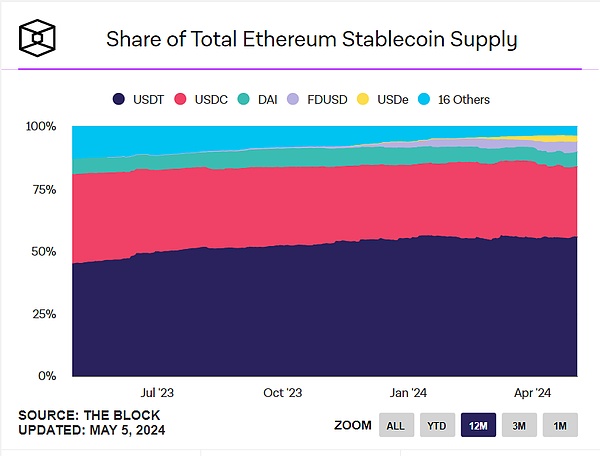
Chart 14: Top 5 Supplies of Stablecoin Track (as of May 2024) Source: The Block
How USDe works: The application of neutral hedging strategies in cryptocurrencies
Ethena Labs’ USDe is a synthetic dollar agreement.In cryptocurrencies, the so-called synthetic US dollar agreement is to achieve a stable peg between the issued stablecoins and the US dollar through a series of combinations of crypto derivatives.
In terms of specific operations, USDe uses the Delta neutral strategy. In the traditional sense, Delta=change of options price/change of underlying asset prices. Then Delta neutral generally refers to the value of the investment portfolio and is not small in assets.The impact of price changes is generally called delta neutral (delta is 0).
Ethena’s neutral strategy operation is as follows.The user minted 1USDe’s Ethena stablecoin, and ENA will also deposit USD 1 worth of ETH on the derivatives exchange and establish a perpetual contract to short 1ETHUSD.If ETH falls 10 times, then the contract earns 9ETH, then the total position of ENA is 10 ETH. Since the price also falls 10 times, it means that the total value of its position has not changed; the price risesSame thing.This is used to ensure the stability of minting stablecoins.If the user chooses to redeem USDe, then ENA will quickly close the short contract.The collateral of USDe is actually spot ETH and corresponding short orders. Under the conditions of a bull market, it is basically 100% full collateral. If ENA tokens are included, the broad collateral ratio exceeds 120%.
The mystery of the rapid rise of USDe: the Ponte-like mechanism, but not only Ponte-like, is essentially a term arbitrage financial product.
First of all, for user minting USDe, after the casting is completed, you can quickly pledge it in Ethena to obtain pledge income.Compared with other stablecoins such as USDT, you will not enjoy dividends at all. In traditional finance, in other words, any currency issuance will be subject to seignite tax. The existing USDT will not be shared at all. USDe will directly receive coin income from it.Take it out.This alone is enough to attract large institutions to participate. After all, when MakerDAO achieved a yield of 8%, the market had taken off directly, not to mention that the sUSDe (staking USDe certificate) once exceeded 30%.
Secondly, for $ENA, it is the project party’s platform governance coin.While pledging USDe to obtain basic income, the project party also gives ENA token rewards.At the same time, if you hold ENA, you can also participate in the pledge, which will increase the reward for pledging USDe accordingly.
Fundamentally speaking, USDe has built a stablecoin architecture based entirely on ETH as the underlying asset. Its core anchor is to maintain the value stability of collateral through derivative futures contracts, using this as a key model. At the same time, in order to attract users,The investment portfolio income is returned to users who mint stablecoins, so that users can not only enjoy the stability of the stablecoin price, but also enjoy the dividends of seigniorage tax together; at the same time, the platform currency ENA is issued, and not only pledge USDe to obtain ENA, but also reverse the situation.It can also increase your income from pledging stablecoins.It has the attribute of Ponte, but it is not a simple Ponte, because its core profit model is a term arbitrage. As an individual, you can actually use this method. ENA is just to concentrate everyone’s funds and make it bigger.Collection of income.
USDe’s profit model:
USDe’s casting itself requires the user’s stETH and cooperate to make short orders in perpetual contracts.There are two parts of the income here, one is the pledge income of stETH (APY 3%-4%), and the other is the capital fee rate for short orders.The funding rate mechanism of perpetual contracts is relatively simple. In order to flatten the contract and spot prices as much as possible, when the long orders in the market are greater than short orders, the long positions will pay the short funds; otherwise, the short positions will pay the long money.In bull markets, the capital fee rate of longs will generally be relatively high (APY25%), otherwise it will be difficult to attract competitors.This part is the biggest profit of the project.It is worth noting that the project party deposited stETH on ordinary CEX, but placed it on hosting platforms such as Cobo and CEFFU to prevent misappropriation or CEX from storing.
USDe Core Risks:
USDe, as a crypto asset-solidified stablecoin, is its most basic model of futures and spot arbitrage. The value of the collateral is actually spot ETH and corresponding short orders. Under the conditions of a bull market, it is basically 100% full collateral, not to mention ENA.The circulating market value of itself means that there is no risk of storm at this stage, but there is an exception that ETH’s LST collateral (stETH) is decoupled from ETH itself. This latest precedent is when 3AC bursts, stETHIt was decoupled by nearly 8% at one point.The biggest risk is the upper limit of scale. If the proportion of short positions on a single exchange is too large, it is likely to face the problem of no competitors, which will lead to a decline in capital fee returns.Judging from the current market situation, the safe casting cap is about US$10 billion.The second is the sustainability issue of pledge yields. This is not detailed and is an obvious issue.There is also the ENA custody model, which also has the risk of evil and even bankruptcy, which will trigger a series of leverage liquidation.The last and biggest risk is the project party’s risk, and the money runs away.
3) Summary of the track of stablecoin mortgage for crypto assets
Compared with stablecoins with fiat currency collateral, stablecoins with crypto assets do not rely on scenarios and centralized exchanges.Whether it is DAI or USDe, its path to success is highly consistent, wealth effect and transparent management.Both DAI and USDe were born in a bull market and grew rapidly.Thanks to the bull market growth, the lending agreement derived from DAI has given retail investors the opportunity to increase leverage to gain higher returns. At the same time, compared with the stablecoins with fiat currency, stablecoins with crypto assets will basically have basic deposit returns.The anchor that attracts customers can be regarded as an interest-generating asset. The wealth effect brought by high returns is the main reason why crypto-staking stablecoins can gain a foothold and spiral upward.Comparing USDT and USDC, if you hold it purely, you cannot enjoy interest-bearing dividends. At the same time, it may also lead to asset depreciation due to changes in the US dollar exchange rate or inflation.
3. Unsecured/algorithmic stablecoin (FRAX)
The last peak of algorithmic stablecoins was UST, an algorithmic stablecoin created by LUNA, which eventually collapsed due to its Ponteau mechanism.Up to now, no algorithmic stablecoins that have become popular in the circle have appeared in the market, and projects such as FRAX are not currently lukewarm.There are two modes of algorithm stablecoins: single-token to multi-token. The former is the main mode of early stable calculation, such as AMPL, ESD, etc.The latter is mainly FRAX (mixed algorithm stablecoins).The biggest drawback of a single token pure algorithm stablecoin is that unless designed as a Pontes model (high yield), it is almost impossible to form a good scenario in growth, and due to the extreme fluctuations in the crypto market, it is difficult to encourage users to use algorithms.Have confidence in itself.On this basis, FRAX developed a model of hybrid algorithm stablecoins.
FRAX designed a relatively complex staking + algorithmic model hybrid stablecoin.The collaterals are mainly USDC and FXS (project governance tokens).Its core foothold is based on arbitrage trading.
The main operating logic is:
When the agreement was first launched, it takes 1 USDC to cast 1 FRAX. As the market demand for FRAX increases, the USDC pledge rate decreases accordingly, and is adjusted to 90%, which means that only 0.9 USDC is required to cast 1 FRAX, and 0.1 FXS is burned at the same timeTokens.If redeemed, then again, the return will be 0.9USDC and 0.1 FXS.This model is stable and essentially relies on arbitrage trading.If FRAX is less than USD 1, the arbitrage trade will buy FRAX, then redeem USDC and FXS, and the FXS will be sold simultaneously to make a profit.As FRAX demand for arbitrage trading increases, the exchange rate can be restored.vice versa.In the latest second edition, the project introduces the Algorithm Market Controller (AMO).The main improvement lies in the provision of FRAX1:1 anchoring the US dollar, putting the collateral of the agreement into other Defi agreements to earn revenue.
Main profit models: expenses for stablecoin minting and destruction, income in various Defi protocols under the AMO mechanism; FRAX lending.In addition, you can also use pledged ETH and other assets to sit on the pledge node to obtain profits.The current total market value exceeds US$600 million.Core bottleneck: Whether it is compared with stablecoins such as USDC/USDT and DAI, even though FRAX improves security through semi-staking, its upper limit is currently limited due to scenario restrictions (arbitrage within the ecosystem).This is also the most important bottleneck for stability, how to expand its application scenarios in the cryptocurrency ecosystem.
4. Track Preview and Hong Kong Stablecoin Thoughts
1. Pros and cons of different types of stablecoins
Whether it is fiat currency collateral, cryptocurrency collateral or unsecured stability, the degree of decentralization, capital efficiency, and price stability of stablecoins have their own advantages and disadvantages and keys to their development.
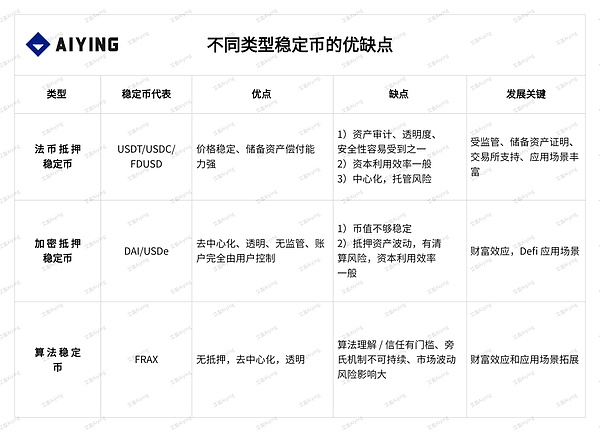
2. Summary of the stablecoin track
Through the inventory of the stablecoin track, we can see that whether it is fiat currency collateral, cryptocurrency, or algorithmic stablecoins.Its common feature lies in the support of application scenarios.Either it has sufficient convenience and credit endorsement, or the use of its stablecoins in the scenario can earn money for users.The rise of USDC proves the importance of regulatory endorsement, the rise of FDUSD proves the importance of the scenario brought by exchange traffic, and the rapid outbreak of USDe has been implemented again. The only thing that has the most driving force for cryptocurrency projects is always the wealth effect.
Based on the above summary and analysis, if you want to find market recognition for a stablecoin project.Under the existing market structure, the path is relatively clear.
1) If it is a stablecoin with a fiat currency.Two essential conditions for success are: one is the trust basis for compliance supervision; the other is the scenario blessing brought by exchange/payment institution traffic.Both are indispensable.
2) Encryption mortgage and calculation stability.The necessary conditions for success are: one is the basic rate of return/high rate of return to solve the user’s demand for crypto asset turnover efficiency; the other is the continuous expansion of Defi/payment application scenarios.If the above two points are met, a stablecoin project will initially have the possibility of success.In addition, the project party always needs to seek trade-offs and balances in three aspects: capital efficiency, value stability and decentralization.
3. Thinking about Hong Kong Stable Coin
For Hong Kong, put aside the peg of the US dollar.The remaining Hong Kong dollars and offshore RMB are pegged.In addition to the rigidity of supervision, it is almost impossible to be in the reality from the perspective of stablecoins. However, the more difficult one is the application scenario problem after minting (or circulation problem). If it cannot be used for large-scale realityPayment or cross-border exchange in the physical world.Just in terms of the crypto world itself, even if there are large exchanges to cooperate with it, there will be major obstacles. After all, the credit and circulation of the US dollar are stronger.From a regulatory perspective, the Hong Kong stablecoin regulatory framework will be launched sooner or later, especially after the Hong Kong virtual asset photography takes effect in 2023, the stablecoin regulatory trend is relatively clear.If it is a fiat currency with Hong Kong dollars as the peg, you can expand the application in the following aspects:
1) Introduce the interest-generating effect of crypto assets into fiat currency pledge.Assets that are about to pledge Hong Kong dollars will be distributed to users through the income from pledged assets, and gain users’ early trust.
2) Hong Kong dollar stablecoin payment.Expand it into a payment tool rather than a simple transaction medium, including cross-border trade in Hong Kong dollar settlement.Furthermore, since the Hong Kong dollar is a related exchange rate, its necessity and appeal are almost minimal if it is not a financial product/payment tool with profit.In addition to Hong Kong dollars, Hong Kong also has over 10 trillion offshore RMB and RMB assets (including offshore RMB bonds), of which offshore deposits are nearly 1.5 trillion, mainly concentrated in Hong Kong, Singapore and other places.In fact, offshore RMB stablecoins are not new, such as TCHN launched by Tron, CNHT launched by Tether, CNHC issued by CNHC Group (the project party was arrested in the mainland in 2023, but not because of the stablecoin project).The main reasons for its not growing yet are, on the one hand, because of the uncertainty of Hong Kong’s regulatory framework, and on the other hand, there is no suitable entry point. For the offshore RMB, the core key points are as follows:
1) The offshore RMB is not subject to domestic and foreign exchange controls, but the identity issue of holding assets is still an obstacle.
Starting from the People’s Bank of China, what I care most about is the legal status of the RMB.If it’s just a stablecoin hook
Offshore RMB is conducive to the internationalization of RMB, and more importantly, it is conducive to the activation of huge separations.
shore RMB assets.The biggest bottleneck at present is that most of the holders of offshore RMB are Chinese mainland.
There are still quite a few difficulties and obstacles in actual operation.
2) There are endorsements from banks such as Bank of China and Hong Kong.Bank of China Hong Kong is an offshore RMB clearing bank.if
Issuing offshore stablecoins, subsequent clearing and custody, if bound to Bank of China Hong Kong, its core trust basis will be
Can be solved.
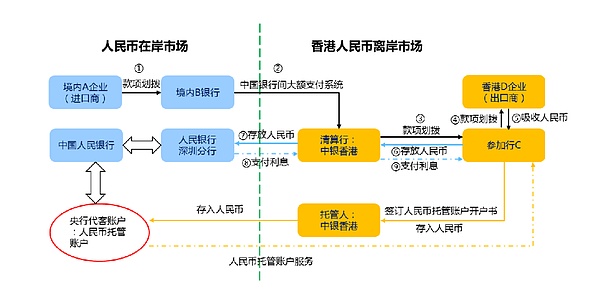
Chart 15: Onshore and offshore RMB flows under cross-border trade
3) Expanding payment and procurement scenarios under cross-border trade will be the most core scenario application of offshore RMB.
The current offshore RMB CNH mainly comes from cross-border trade, procurement, and payment, and then forms a retention in Hong Kong/Singapore, especially in countries on the Belt and Road Initiative.Because from the perspective of the global offshore dollar, most countries are very short of the dollar, and with the instability of the local currencies of many countries, trade with China will be accumulated in the form of RMB.Through the offshore RMB stablecoin/USDC trading pair, the channel for RMB to USD in the Belt and Road countries will be greatly improved. In addition, payments under trade items can be made. Cross-border payment institutions can cooperate with cross-border payment institutions to explore payments for e-commerce, games, and commodity transactionsScene.
4) You can try to build a unique income model of offshore RMB.In addition to the traditional casting and redemption fees, the more important thing is how to reward users’ revenue expectations.You can also try to mix RMB mortgage with US dollar asset mortgage to achieve exchange rate neutrality and achieve higher stability, while obtaining two-way short-term financial returns for asset management, and then as the basic returns of stablecoins.In addition, it is also possible to consider securitizing the physical assets of domestic high-level credit entities (RWA) overseas, as another anchor direction for stablecoin returns (refer to DAI), including the foreign exchange derivatives market for offshore RMB..In addition, offshore bonds of up to 300 billion yuan each year can also be issued tokenized.
Overall, the biggest difficulty of the current Hong Kong dollar stablecoin or offshore RMB is not the issuance, but the design of application scenarios. From the future trend development, offshore RMB has a wider range ofApplication space and scenarios.If the RMB is strongly anchored and regulated under the Hong Kong framework, it will not directly conflict with the status of the RMB fiat currency, but at the advantage, it can expand the payment convenience of offshore RMB (no bank account opening, payment anytime, anywhere).At the same time, it enriches the global issuance of domestic RMB assets and greatly expands the global flow of domestic RMB assets.This has a certain policy space and acceptance in the current cycle of stricter foreign exchange controls and economic downturn.








